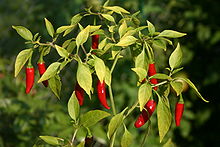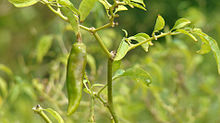 |
|
|
|
|
| Cuisines | Herbal | Spice | Curry | Yeast | Recipe | ||||||
|
Chili Pepper The chili pepper (also chile pepper or chilli pepper, from Nahuatl chīlli) is the fruit of plants from the genus Capsicum, members of the nightshade family, Solanaceae. The term in British English and in Australia, New Zealand, India, Malaysia and other Asian countries is just chilli without pepper. Chili peppers originated in the Americas. After the Columbian Exchange, many cultivars of chili pepper spread across the world, used in both food and medicine. Species and cultivarsThough there are only a few commonly used species, there are many cultivars and methods of preparing chili peppers that have different names for culinary use. Green and red bell peppers, for example, are the same cultivar of C. annuum, immature peppers being green. In the same species are the jalapeño, the poblano (which when dried is referred to as ancho), New Mexico (which is also known as chile colorado), Anaheim, serrano, and other cultivars. Peppers are commonly broken down into three groupings: bell peppers, sweet peppers, and hot peppers. Most popular pepper varieties are seen as falling into one of these categories or as a cross between them. Culinary usesChili pepper pods, which are berries, are used fresh or dried. Chilies are dried to preserve them for long periods of time or may also be done by pickling. Dried chilies are often ground into powders, although many Mexican dishes including variations on chiles rellenos use the entire chili. Dried whole chiles may be reconstituted before grinding to a paste. The chipotle is the smoked, dried, ripe jalapeño. Many fresh chilies such as poblano have a tough outer skin which does not break down on cooking. Chiles are sometimes used whole or in large slices, by roasting, or other means of blistering or charring the skin, so as not to entirely cook the flesh beneath. When cooled, the skins will usually slip off easily. The leaves of the chili plant, which are mildly bitter and nowhere near as hot as the fruit, are cooked as greens in Filipino cuisine, where they are called dahon ng sili (literally "chili leaves"). They are used in the chicken soup, tinola. In Korean cuisine, the leaves may be used in kimchi. In Japanese cuisine, the leaves are cooked as greens, and also cooked in tsukudani style for preservation. Chili is by far the most important fruit in Bhutan. Local markets are never without chili, always teemed with different colors and sizes, in fresh and dried form. Bhutanese call this crop ema (in Dzongkha) or solo (in Sharchop). Chili is a staple fruit in Bhutan; the ema datsi recipe is entirely made of chili mixed with local cheese. Chili is also an important ingredient in almost all curries and food recipes in the country. In India, most households always keep a stack of fresh hot green chilis at hand, and use them to favour most curries and dry dishes. It is typically lightly fried with oil in the initial stages of preparation of the dish. Some states in India, such as Rajasthan, make entire dishes only by using spices and chilies. Fresh or dried chilies are often used to make hot sauce, a bottled condiment to add spice to other dishes. Hot sauces are found in many cuisines including harissa from the Middle East, chili oil from China (known as rāyu in Japan), and sriracha from Thailand. Medicinal Capsaicin is a safe and effective topical analgesic agent in the management of arthritis pain, herpes zoster-related pain, diabetic neuropathy, post mastectomy pain, and headaches. Nutritional valueRed chilies contain high amounts of vitamin C and carotene (provitamin A). Yellow and especially green chilies (which are essentially unripe fruit) contain a considerably lower amount of both substances. In addition, peppers are a good source of most B vitamins, and vitamin B6 in particular. They are very high in potassium, magnesium, and iron. Their high vitamin C content can also substantially increase the uptake of non-heme iron from other ingredients in a meal, such as beans and grains. |











